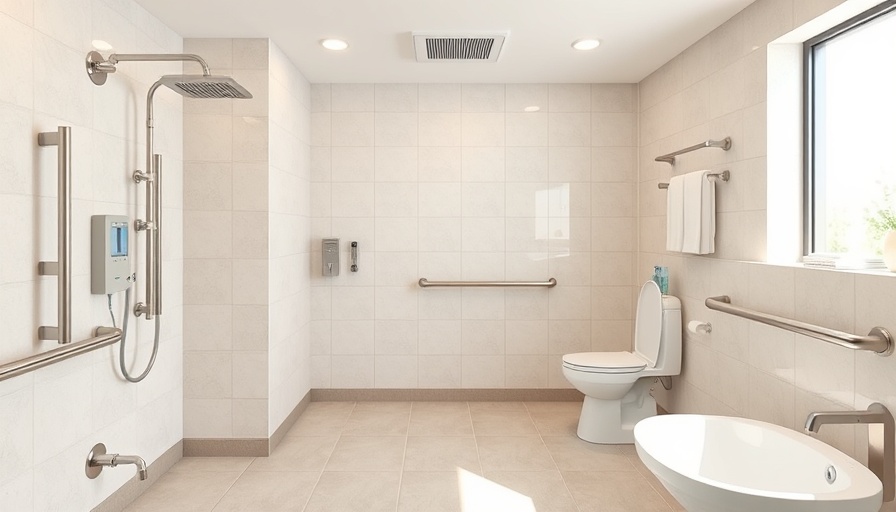
Why Accessible Bathrooms Matter for Everyone
As our lives evolve, the spaces we inhabit should evolve with us. In Toms River, many residents are confronting the realities of aging parents, impending mobility issues, or growing families. Planning for the future requires proactive steps toward creating accessible environments that benefit all. An ADA-compliant bathroom does not merely cater to those with disabilities; it becomes a sanctuary of convenience, significantly improving the daily functions of all who share the space.
The Foundation of ADA Compliance
The Americans with Disabilities Act (ADA) was introduced to level the playing field for those with disabilities, ensuring they can access facilities and services on an equal footing with everyone else. This legislation underscores the importance of accessible design. For homeowners in Toms River, understanding ADA compliance isn’t just necessary for adhering to local regulations; it’s a conscientious choice that reflects the community's values around inclusion and support.
Financial Incentives of ADA Bathrooms
Homeownership in Toms River is on the rise, and with it, the demand for features that promote accessibility. Installing an ADA bathroom can enhance your home's marketability. As older adults seek to downsize or relocate, they increasingly prefer homes equipped with accessible features. This demand can lead to an increased property value, ensuring that your investment pays off in more ways than one.
A Stylish Approach to Accessibility
There’s a misconception that accessibility must come at the cost of aesthetics. Fortunately, modern designs harmoniously blend style with functionality. From sleek grab bars in finishes that match your fixtures to luxurious roll-in showers that create a spa-like atmosphere, designing an ADA-compliant bathroom can be both practical and visually appealing. Homeowners often find that adding ADA features actually enhances the overall look of their bathrooms.
Key Design Features of an ADA-Compliant Bathroom
When designing an ADA-compliant bathroom, homeowners should consider essential features including:
- Wider Doorways: To accommodate wheelchairs and walkers, doorways should be at least 32 inches wide.
- Grab Bars: Strategically placed grab bars offer added support around toilets and in showers.
- Accessible Showers: Roll-in or curb-less showers provide easy access without barriers.
- Heightened Vanities: Countertops should accommodate seated individuals, making grooming easier for everyone.
These elements are indispensable in enhancing the accessibility and usability of bathrooms for all family members.
Embracing Future Trends in Home Design
Looking ahead, the need for accessible living environments is growing. The aging Baby Boomer population and increased life expectancy mean more individuals will require homes that accommodate mobility challenges. Additionally, more young families are recognizing the benefits of accessibility, creating a shift in demand towards homes that meet the needs of diverse life stages.
Actionable Steps for Homeowners
Many homeowners might feel overwhelmed by the thought of navigating regulations and design options. Here are a few steps to get started:
1. **Assess Your Current Bathroom**: Identify areas that may pose challenges for family members or guests.
2. **Research ADA Standards**: Understand the specific compliance requirements for new constructions or renovations.
3. **Seek Professional Advice**: Engage with contractors experienced in ADA-compliant renovations for tailored solutions.
Connecting with the Community
Communities thrive when they embrace flexibility and support. By installing ADA-compliant features, Toms River homeowners contribute to a culture of inclusion, ensuring all residents, regardless of ability, can confidently navigate their homes. The enhancement of loved ones’ quality of life begins at home, and simple adjustments can make substantial impacts.
As you consider how to make your home a space that welcomes everyone, remember that an ADA bathroom is not merely a renovation; it’s an investment in your family's future well-being. Embrace the shift towards accessibility now, and create a living environment that will stand the test of time.
Don't wait for others to take the lead. Start planning your home's modifications today—contact local contractors knowledgeable in ADA compliance to discuss your options!
 Add Row
Add Row  Add
Add 




 Add Row
Add Row  Add
Add 

Write A Comment